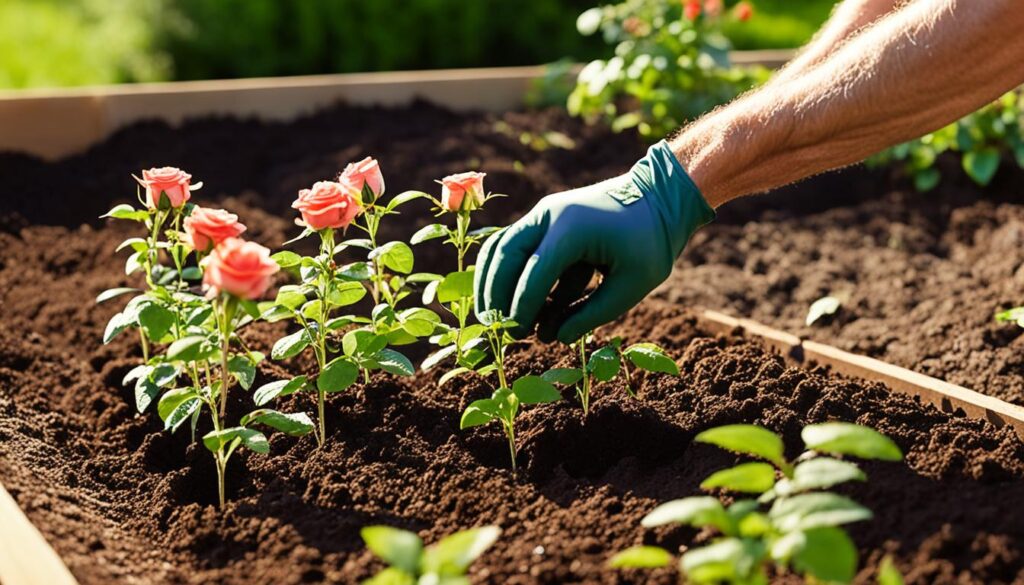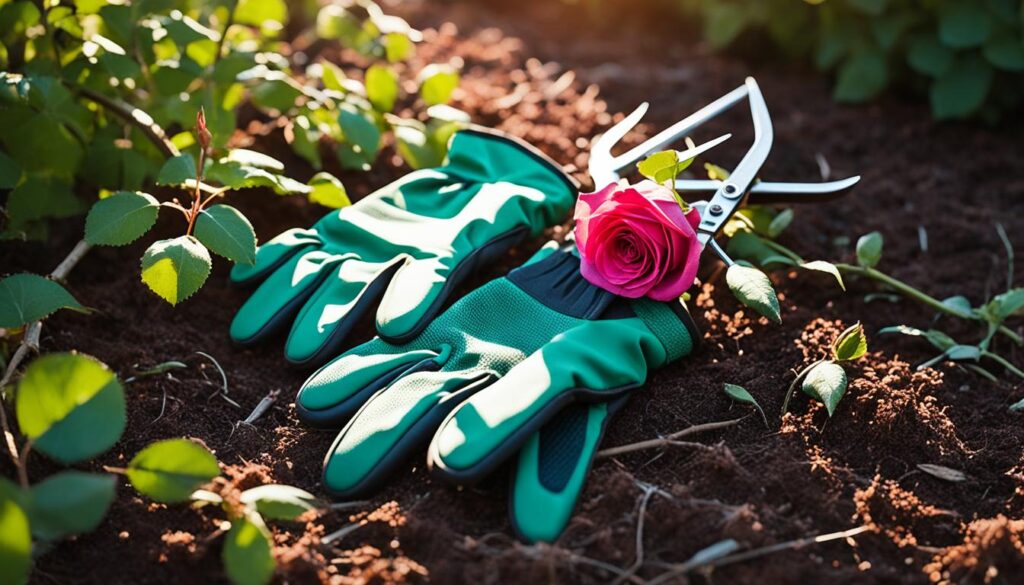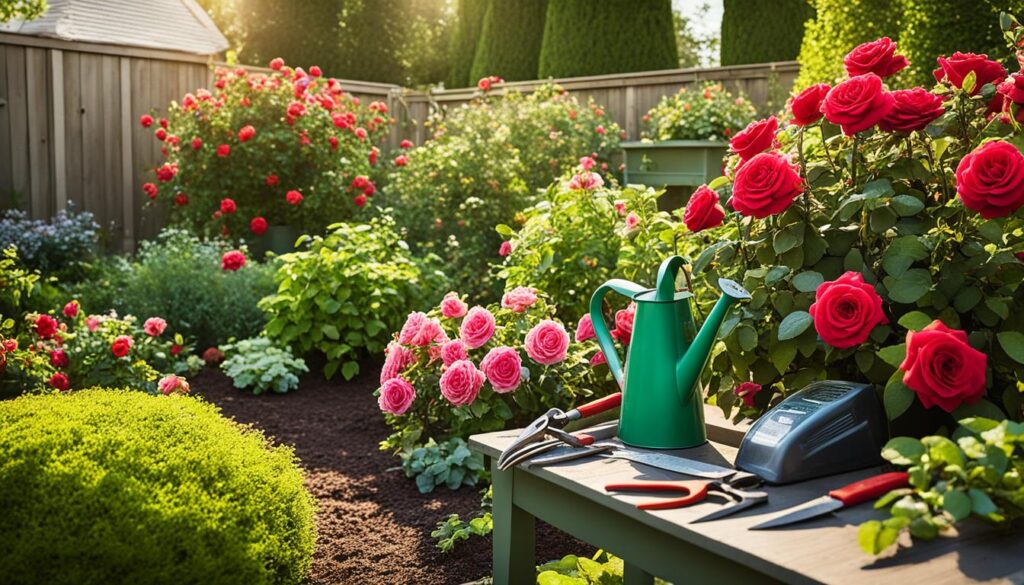How to Grow Beautiful Roses- Expert Tips for Beginners
Do you dream of a garden full of beautiful, fragrant roses? Growing stunning roses is easier than you think with the right rose gardening tips. This guide will give you expert advice on picking the best roses for beginners. You’ll learn how to prepare your garden, plant roses correctly, and care for them to make sure they bloom every year.
Learn about the different types of roses and how to prune and train climbing roses. This rose care guide will teach you everything you need to know to create a beautiful rose garden. You’ll find out how to plant roses like an expert, keep your plants safe from pests and diseases, and design a garden that will make your neighbors jealous.
Introduction
Growing roses can be both rewarding and challenging for beginners. They have delicate blooms and thorny stems. But with the right knowledge, even new gardeners can enjoy their beauty and scent.
This guide offers expert tips for growing beautiful roses. We’ll cover everything from choosing the right types for your area to pruning and protecting them. You’ll learn all you need to know about rose gardening to succeed.
Whether you’re experienced or just starting, this guide will give you the skills and confidence. You’ll be able to create a beautiful rose garden that will impress everyone.
“Roses do not bloom hurriedly; for beauty, like any masterpiece, takes time to unfurl its petals.”
– Matshona Dhliwayo
Choosing the Right Roses for Your Garden
Choosing the right roses is key to a beautiful garden. Think about your local USDA hardiness zone, sunlight, and climate. This helps your roses grow well.
Types of Roses
There are many rose types, each with unique features. Some popular ones include:
- Hybrid Teas – These roses have big, classic blooms and long stems. They’re great for cutting gardens and bouquets.
- Floribundas – They produce clusters of small flowers that bloom a lot. This makes your garden colorful and lively.
- Grandifloras – These roses have large, elegant flowers and bloom a lot. They’re a mix of hybrid teas and floribundas.
- Shrub Roses – These roses are tough, need little care, and grow into dense bushes. They bloom a lot during the season.
- Climbing Roses – These roses grow up structures like trellises. They add height and beauty to your garden.
Best Roses for Beginners
If you’re new to rose gardening, start with easy-to-grow types. Experts suggest roses that are disease-resistant and low-maintenance. Good choices for beginners are:
- Knockout Roses – These shrub roses bloom a lot, resist diseases, and come in many colors.
- Drift Roses – They’re small, spread out, and bloom a lot. They need little pruning.
- David Austin Roses – These roses mix old-fashioned beauty with modern disease resistance and bloom again.
Choosing roses that fit your garden and your experience will make your rose garden beautiful. It will bring joy and beauty for many years.
Preparing Your Garden for Roses
To grow a successful rose garden, you need to pick the right spot and prepare the soil. Roses are picky about where they grow. So, it’s important to choose the best rose garden location and make sure the rose soil requirements are met at your rose planting site.
Site Selection
Find a spot for your rose garden that gets at least 6-8 hours of sunlight each day. Roses do well in soil that drains well and should be planted where they won’t compete with trees or shrubs, or where people walk a lot. Don’t pick a spot with bad air flow or high humidity, as these can make roses more likely to get diseases.
Soil Preparation
- Check your soil’s pH level and try to keep it between 6.0 and 6.5, which roses like best.
- Add compost or other organic stuff to the soil to help with drainage and nutrients.
- If your soil is too clay-heavy, mix in some sand or grit to help air and water move through it better.
- Don’t use fresh manure because it can hurt rose roots. Use composted manure instead.
By picking the right rose garden location and getting the rose soil requirements ready for your rose planting site, you’ll give your roses the best chance to grow and bloom well.
“The key to a successful rose garden is choosing the right spot and preparing the soil properly.”
Planting Roses
Choosing the right time to plant roses is key for their growth and blooms. Spring or fall are the best seasons. These times offer mild temperatures and help the plants grow strong roots before the harsh summer or winter.
When to Plant
Spring, from April to May, and fall, from September to October, are ideal for planting roses. These seasons let the plants grow strong roots before the tough weather hits.
Planting Techniques
- Dig a wide, deep hole for the rose’s roots to spread out.
- Plant the rose at the same depth it was in the container or nursery.
- Fill the hole with soil, packing it firmly around the roots.
- Water well to settle the soil and remove air pockets.
Watering Tips
Watering is key for new roses to grow well. They need about 2-3 gallons of water per plant, once or twice a week. Make sure to water deeply, reaching the roots, and avoid too much water to prevent root rot.
| Planting Time | Watering Frequency | Water Needed per Plant |
|---|---|---|
| Spring | 1-2 times per week | 2-3 gallons |
| Fall | 1 time per week | 2 gallons |
Knowing the best times to plant, how to plant, and how much water roses need gives your roses a great start. This leads to a beautiful, thriving garden.

Caring for Your Roses
Keeping your rose plants healthy and thriving is key. Roses can be a bit high-maintenance, but the right care makes them worth it. With the right techniques, you can enjoy a beautiful rose garden all season.
Watering Roses
Roses need a lot of water to stay healthy. Aim to give each plant about 2-3 gallons of water, 1-2 times a week. This keeps the soil moist but prevents it from getting too wet. Proper rose watering helps with strong roots and beautiful blooms.
Fertilizing Roses
Feeding your roses is crucial. Use a balanced, slow-release rose fertilizer in early spring, after the first bloom, and again in midsummer. This gives them the nutrients they need for lush foliage and beautiful flowers all season.
Mulching
Adding 3-4 inches of organic material like wood chips or pine needles around your roses is beneficial. Mulching roses keeps the soil moist, stops weeds, and adds nutrients as it breaks down. This simple step greatly improves your rose garden’s health and look.
“Caring for roses is a labor of love, but the rewards are well worth the effort. With the right watering, fertilizing, and mulching techniques, you can have a stunning rose garden that will be the envy of your neighborhood.”
Follow these expert tips for rose watering, rose fertilizer, and mulching roses. You’ll be on your way to a beautiful, thriving rose garden that brings you joy and inspiration.
Pruning and Training Roses
Keeping your rose plants healthy and full of blooms is key to a great garden. Pruning is a vital part of rose care. It cuts away dead or damaged canes, encourages new growth, and directs energy to flower production.
Why Pruning is Important
Pruning is essential for several reasons. It keeps your roses looking neat and encourages them to grow outward. It also boosts the production of new, healthy canes for more flowers. Plus, it removes dead or diseased wood, keeping your roses strong and resilient.
Pruning Techniques
Pruning roses means making clean cuts just above outward-facing buds. This helps the plant grow outward and look better. Use sharp shears to cut cleanly and prevent disease or damage.
Training Climbing Roses
For climbing roses, training is key to showing off their blooms. By guiding the canes onto a trellis, you help them grow up. Regular pruning and training keep your climbing roses looking great and thriving.
| Pruning Technique | Description |
|---|---|
| Angled Cuts | Make clean, angled cuts just above outward-facing buds to encourage outward growth. |
| Removal of Dead/Damaged Wood | Prune away any dead, damaged, or diseased canes to maintain plant health and vigor. |
| Thinning | Selectively remove some canes to improve air circulation and light penetration. |

“Proper pruning is the key to unlocking the full potential of your rose garden, leading to a stunning display of blooms and a healthy, thriving plant.”
Learning how to prune and train your roses keeps them in top shape. This leads to a beautiful garden full of roses for years.
Protecting Roses from Pests and Diseases
Keeping your rose garden healthy and beautiful means watching out for pests and diseases. By being proactive and acting fast when problems arise, you can keep your roses in top shape. This ensures they stay healthy for a long time.
Aphids are a common problem for roses. These tiny insects suck the sap, slowing down plant growth. To fight them, you can bring in ladybugs or lacewings that eat aphids. Or, use organic soap or neem oil to kill them off.
Spider mites are another issue for rose owners. These tiny bugs make fine webs on leaves, causing them to turn color and wilt. A strong spray of water can knock them off and reduce their numbers.
- Pick roses that are resistant to diseases like black spot and powdery mildew.
- Make sure there’s good air flow around your roses to stop fungal spores from spreading.
- Use organic fungicides, like sulfur or neem oil, right away if you see disease signs.
Being watchful and dealing with pests and diseases fast is key to a healthy rose garden. By using these organic steps, you can have beautiful roses all season.
| Common Rose Pests | Symptoms | Organic Control Methods |
|---|---|---|
| Aphids | Small, sap-sucking insects that cause stunted growth and distorted leaves | Introduce beneficial insects, use insecticidal soap or neem oil |
| Spider Mites | Tiny arachnids that spin fine webs on the undersides of leaves, leading to discoloration and wilting | Spray plants with a strong jet of water to dislodge mites |
| Black Spot | Fungal disease that causes circular black spots on leaves, leading to premature leaf drop | Choose disease-resistant varieties, maintain good air circulation, apply organic fungicides |
| Powdery Mildew | Fungal disease that appears as a white, powdery growth on leaves and stems | Choose disease-resistant varieties, maintain good air circulation, apply organic fungicides |
“Healthy roses start with prevention. By taking proactive steps to protect your plants, you can ensure a vibrant, thriving rose garden all season long.”
Seasonal Rose Care
Caring for your roses needs a special approach all year. By changing your care based on the season, your rose garden will stay healthy and blooming.
In early spring, start by pruning and fertilizing your roses. Pruning helps new growth and makes strong, healthy canes. Then, use a balanced rose fertilizer to give your plants the nutrients they need for the growing season.
When summer comes, make sure to water your roses often. Also, remove dead flowers to make your garden look better and help your roses grow more flowers.
Watch out for pests and diseases in summer. Quickly fix any problems to keep your roses healthy and strong.
As autumn nears, get your roses ready for the cold months. Stop feeding them and let them prepare for winter. This way, your roses will be strong enough to come back in spring.
| Season | Rose Care Tasks |
|---|---|
| Spring |
|
| Summer |
|
| Autumn |
|
By following a seasonal rose care by season and rose maintenance schedule, your rose garden will stay healthy, vibrant, and beautiful all year.

Designing a Beautiful Rose Garden
Creating a stunning rose garden means thinking about the layout and the colors and scents of the roses. By arranging your roses well and picking ones that please the senses, you can make a garden that looks amazing and feels like a special place.
Garden Layout
When planning your rose garden, put roses of the same type or color together. This makes a strong and eye-catching look. Or, mix different types of roses for more depth and interest.
Think about adding paths, trellises, or other features to guide through your garden. Benches or places to sit can also let visitors enjoy the beauty and smell of your roses.
Color and Fragrance
The colors and smells of your roses change how your garden looks and feels. Choose roses in many colors, like red, pink, yellow, lavender, and even those with more than one color.
Pick roses that smell good to make your garden more exciting. Roses with a sweet smell can turn your garden into a place that delights all your senses. Place your roses so the smell is everywhere in your garden.
By thinking about the layout, colors, and smells of your roses, you can make a beautiful and peaceful rose garden. It will be a place that looks great and brings joy for many years.
Troubleshooting Common Problems
Your rose plants may face issues like pests, diseases, or stress. Knowing how to spot and fix these problems is key to keeping your roses healthy and beautiful.
Identifying Rose Issues
Learn the signs of rose problems to quickly find and fix them. Common issues include:
- Discolored, wilting, or distorted leaves – could indicate pests, diseases, or nutrient deficiencies
- Powdery or black spots on leaves – may be signs of fungal diseases like powdery mildew or black spot
- Cane dieback or stem damage – can be caused by winter injury, disease, or pest infestations
- Lack of blooms or poor flower quality – often due to improper pruning, insufficient sunlight, or nutrient imbalances
Solutions and Preventative Measures
After spotting a problem, take steps to fix it and prevent it from happening again. Some effective solutions and preventative measures include:
- Using targeted treatments, like horticultural oils or fungicides, to manage rose pests and diseases
- Adjusting how you care for your roses, such as watering, fertilizing, and pruning
- Choosing rose varieties that are more resistant to common problems in your area
- Keeping your garden clean by removing fallen leaves and debris to reduce disease spread
- Watching your roses closely and fixing problems quickly to stop them from getting worse
By being alert and taking action early, you can keep your roses healthy and your garden beautiful.
Conclusion
In this guide, you’ve learned how to grow beautiful roses in your garden. We covered the best ways to pick varieties, care for them, and maintain them all year. This will help you achieve rose gardening success.
Recap of Key Points
By using the expert advice in this article, you can grow roses that make your garden colorful, fragrant, and joyful. It’s important to pick the right rose types, prepare the soil well, and know how to plant them. Also, watering and feeding them right is key to rose growing summary.
Encouragement
Even if you’re new to gardening, you can still grow roses and enjoy the rewards. So, why not start today and begin your rose-growing adventure?
Call to Action
The advice in this article will help you grow roses with confidence. Enjoy taking care of these lovely plants. Let your garden fill with the bright colors and classic beauty of roses.
FAQ
What are the best rose varieties for beginners?
How much sunlight do roses need?
When is the best time to plant roses?
How often should I water my rose plants?
How do I properly prune my rose plants?
What are common rose pests and diseases?
How do I design a beautiful rose garden?
- 10 Must-Have Blooms for Your 2025 Garden
- The Health Advantages of Gardening You Need to Know
- How to Create a Small Vegetable Garden Layout Plan: A Beginner’s Guide
- DIY Garden Projects for Small Spaces: Upcycling Ideas to Maximize Your Garden
- Watering Techniques for Small Gardens: Ensuring Your Plants Thrive
- Small Border Plants for Landscaping: Adding Beauty and Functionality to Your Garden
- Year-Round Small Space Gardening: Seasonal Planting Tips for Maximum Harvest
- Essential Tools for Small-Space Gardening: What You Really Need
- The Ultimate Guide to Container Vegetables: What to Grow in Small Spaces
- Budget-Friendly Gardening: How to Create a Thriving Garden on a Tight Budget
- How to Optimize Sunlight in Small Gardens: Tips for Better Plant Growth
- DIY Vertical Planters: Creative Ideas for Small Space Gardening
- Companion Planting for Small Vegetable Gardens: Boost Growth and Deter Pests
- Container Gardening Essentials: Choosing the Right Pots, Soil, and Plants
- Vertical Gardening Techniques: Maximizing Your Small Space with Climbers and Vines
- How to Build a Raised Bed Garden in a Small Backyard: Step-by-Step Guide
- The Best Vegetables for Small-Space Gardens: High-Yield Varieties You Need to Grow
- Smart Vegetable Garden Layouts for Small Spaces: Maximizing Your Green Thumb in Compact Areas
- 40. Best Practices for Managing a Sustainable Garden Year-Round
- Building a Wildlife Pond for Biodiversity
- Advanced Techniques in Sustainable Gardening
- How to Create a No-Till Garden
- The Mental Health Benefits of Gardening
- Using Technology to Enhance Sustainable Gardening
- Getting Certified Organic: Steps and Benefits

Leave a Reply